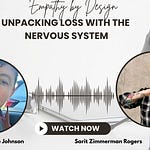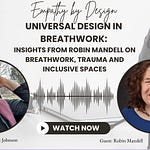Bridging Empathy and Innovation: Reflecting on the Liminal Spaces of Virtual Reality
What does it mean to truly connect with others, especially in a world where technology often mediates our interactions? This question stirred something within me while reflecting on the podcast Empathy By Design. It’s a conversation that doesn’t just explore technology but dives deep into our shared humanity, the complexities of emotion, and the potential for healing in the most unexpected of places.
One of the most poignant ideas presented by Dr. Ruth Diaz, an expert in psychology, conflict resolution, and the integration of virtual reality (VR), is how we can intentionally design for empathy. By consciously creating environments that hold space for complex emotions and diverse perspectives, we can transform how we connect with ourselves and the world around us. Her insights resonated for their trauma-informed lens, emphasizing the importance of safety, exploration, and curiosity in every interaction.
Navigating Conflict through a Trauma-Informed Lens
Conflict is a part of life. However, for many of us, conflict can be triggering, calling up past experiences of harm or invalidation. Dr. Diaz’s DOT model (Deepen, Orient, Transform) offers a gentle, trauma-informed framework for navigating these moments. Unlike traditional approaches that focus solely on resolving conflict, the DOT model invites us to explore it.
The first step, Deepen, asks us to lean into the emotions beneath the surface. Instead of suppressing anger, sadness, or frustration, we’re encouraged to acknowledge and hold space for them. These feelings are not inconveniences to be dismissed; they are messages from our nervous system, asking for attention. This approach reminds me of somatic practices where we tune into bodily sensations, allowing our emotions to have a voice without judgment.
Orient is about finding your footing in the midst of tension. If you’ve ever been in a heated argument or felt overwhelmed by a challenging situation, you know how disorienting it can be. This part of the process emphasizes grounding yourself, whether through breath, awareness of your body, or reconnecting to your surroundings. It’s a reminder that, even in the midst of conflict, we can anchor ourselves in safety.
Finally, Transform invites a shift in perspective. Transformation doesn’t mean the conflict disappears or that all issues are resolved. Instead, it’s about viewing the experience as an opportunity for growth, connection, and learning. Through this lens, conflict becomes less of a threat and more of an invitation to understand both ourselves and others on a deeper level.
The Power of Emotional Literacy
One of the most impactful aspects of Dr. Diaz’s framework is its emphasis on emotional literacy. This concept goes beyond simply naming emotions; it’s about making space to fully feel and understand them. Many of us grow up internalizing messages that emotions like anger are bad or that sadness makes us weak. Over time, we learn to numb, bury, or dismiss these feelings, leaving little room for healthy expression or understanding.
But what if we approached emotions with curiosity instead of fear? What if we viewed them as essential parts of our human experience, instead of problems to be fixed? Emotional literacy allows us to break free from binary thinking like “right versus wrong,” offering a way to approach interactions with more empathy and compassion.
For me, this feels profoundly trauma-informed. It’s permission to move at your own pace, honoring your emotional state while building tools to connect with others more authentically. This practice not only creates stronger personal relationships but also fosters communities that value empathy and mutual understanding.
Virtual Reality as a New Frontier for Connection
What does virtual reality have to do with all of this? At first glance, VR might seem like the opposite of intimate human connection. How can something so tech-driven touch the essential, emotional core of who we are? Dr. Diaz argues that VR offers an opportunity to expand our understanding of connection. Not replace it, but enhance it.
Through VR, individuals can step into spaces filled with possibilities—for healing, for empathy, and for exploration. It creates an immersive environment where we can embody perspectives outside our own, challenging us to feel beyond the traditional boundaries of our lived experience. For example, imagine entering a virtual space that replicates what it feels like to walk in someone else’s shoes or navigating peaceful environments designed specifically for grounding and nervous system regulation. Such experiences go beyond observation and invite an embodied sense of empathy.
At the same time, VR isn’t without its challenges. Digital spaces can bring new dynamics of conflict and discomfort. But even here, the DOT model proves its value. Dr. Diaz describes using curiosity and empathy as tools to approach these challenges, turning potentially harmful experiences into opportunities for collective insight and growth.
It’s in these digital, liminal spaces that we can push beyond the binary of “real” versus “virtual” and explore the richness of human connection in all its forms.
Embodied Empathy as the Bridge
What stayed with me most after reflecting on this podcast was the idea of embodied empathy. We often think of empathy as purely intellectual or emotional, but what happens when we bring the body into it? When we incorporate mindfulness, somatic awareness, and nervous system insight, empathy becomes something we live. It’s no longer just about stepping into someone else’s shoes but about feeling grounded and present enough within ourselves to hold space for others.
This is where trauma-informed practices are so crucial. They remind us that connection starts with safety. Without safety, there can be no vulnerability, and without vulnerability, empathy becomes performative. Technology, when designed with these principles in mind, holds immense potential to create environments where both safety and authentic connection can thrive.
Lessons for Personal and Collective Growth
As I reflect on the intersection of empathy and innovation, I’m reminded of how much these principles resonate in my own life. Whether we’re navigating conflict, exploring virtual reality, or simply trying to show up for the people around us, there’s a quiet invitation to lean into connection. Not the kind of connection that insists on constant positivity or perfection but one that embraces the full spectrum of human experience, including its messiness.
The work of Dr. Diaz is a testament to what can happen when we intentionally bridge empathy and innovation. It challenges us to think beyond what is and imagine what could be—not just in technology but in ourselves and our communities.
What would it look like if we all approached our interactions, both online and offline, through the lens of safety, empathy, and curiosity? How might these practices transform not just our relationships but also the ways we engage with the world as a whole?
While we may never have all the answers, I find comfort in knowing that exploring these questions is a step toward creating spaces of meaningful connection. Whether in the tactile world or the realm of virtual reality, we have the capacity to deepen our empathetic roots and grow something truly remarkable.
Call to action
Go follow Dr. Diaz
Wanna dive deeper and learn with us? Go see our trauma-informed leadership certifications and microcourses












Share this post